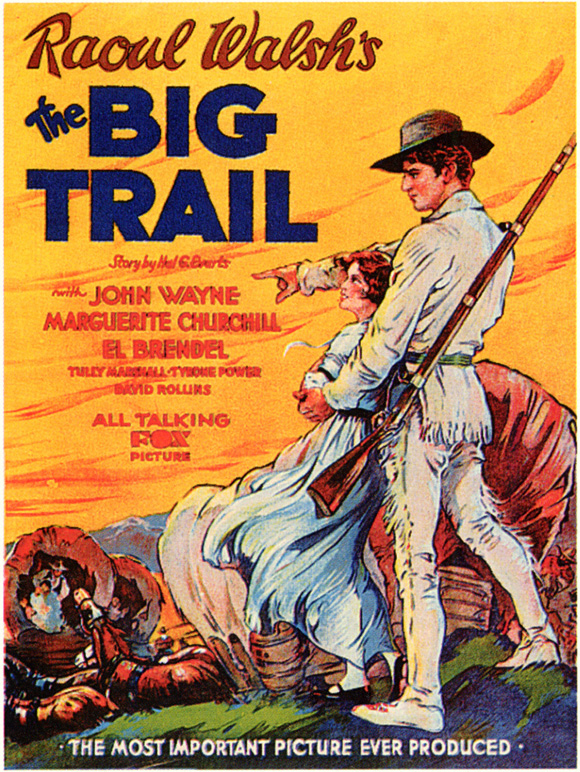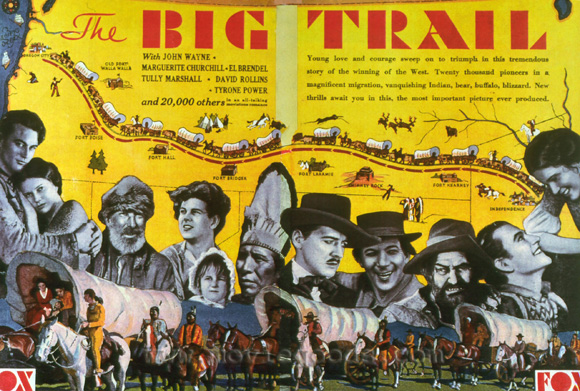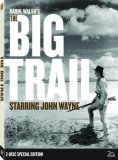| Reviews & Columns |
|
Reviews DVD TV on DVD Blu-ray 4K UHD International DVDs In Theaters Reviews by Studio Video Games Features Collector Series DVDs Easter Egg Database Interviews DVD Talk Radio Feature Articles Columns Anime Talk DVD Savant Horror DVDs The M.O.D. Squad Art House HD Talk Silent DVD
|
DVD Talk Forum |
|
|
| Resources |
|
DVD Price Search Customer Service #'s RCE Info Links |
|
Columns
|
|
|
Big Trail (2-Disc Special Edition), The
Incredibly, five different versions of the film were shot simultaneously: one in the 70mm Grandeur process for exhibition in the biggest movie palaces, another in standard 35mm for general release, plus three foreign-language versions with (mostly) different casts, all shot in standard 35mm: in French, German, and Italian. Fox originally released The Big Trail to DVD in May 2003, but that disc consisted only of the 110-minute standard 35mm version. Fox's new 2-Disc Special Edition includes a 122-minute version of the Grandeur version (reportedly The Big Trail debuted at 158 minutes, but this is unconfirmed) in all its 16:9 enhanced widescreen glory along with some good extras on Disc 1, while Disc 2 includes the previously available 35mm version. The second disc is actually the exact same DVD from 2003.
Overall, this is a great release but begs the obvious question: Where's the Blu-ray? It seems downright perverse to limit The Big Trail's large negative splendor to standard DVD when Blu-ray could really do the film right. Clearly, Fox Home Entertainment isn't convinced a 1930 Western's projected sales would justify the expense of a Blu-ray edition, John Wayne's marquee value notwithstanding - though perhaps they're thinking that in five or six years when Blu-ray has a firmer grip on the market a high-def version might then perhaps be warranted. In the meantime this is it, folks.
The Big Trail follows a massive wagon train from the banks of the Mississippi to the American Northwest. Wayne plays trapper-turned-trail scout Breck Coleman, who joins the serpentine wagon train searching for the men who murdered Ben Grizzel, Breck's father-figure trapper friend, stole his furs and disguised their crime to make it look like Ben was butchered by Indians.
Breck doesn't have to look very far. Wagon boss Red Flack (Tyrone Power, Sr.) and bullwhacker Lopez (Charles Stevens, reportedly a real-life grandson of Geronimo) establish an antipathy with Breck from the get-go. Meanwhile, Thorpe (Ian Keith), a crooked gambler masquerading as a Southern gentleman (with ties to Flack and Lopez to boot), muscles in on Breck's romantic interests in Ruth Cameron (Marguerite Churchill), a delicate pioneer woman making her way west with brother Davey (David Rollins).
Along the way, the pioneers and their prairie schooners face one seemingly insurmountable obstacle after another: dangerous rivers to ford, the constant threat of disease, starvation, Indian attack, etc. All the while Breck and his sidekick, Zeke (Tully Marshall) gather evidence in anticipation of meting out pioneer justice when the time is right.
There's nothing in all of cinema quite like The Big Trail. On one hand it has obviously been patterned after silent Western epics like The Iron Horse and The Covered Wagon, but this early talkie is much bigger in scale and arguably more aesthetically sophisticated and realistic. (Indeed, it's more authentic than Ron Howard's similar but vastly inferior Far and Away.)
It's a strange film to look at. On one hand the widescreen compositions by Arthur Edeson (Mutiny on the Bounty, Casablanca) are incredibly sophisticated, closer to early Russian widescreen films like Ilya Muromets (1956) than the earliest Hollywood CinemaScope films. Most frequently Walsh and Edeson fill the frame tableaux style in the manner of Remington. The balance between foreground and background is impeccable, and though there are few close-ups and not of lot of movement within individual shots, the mise-en-scene is superb throughout.
And there's plenty to look at. Statistics vary: reportedly the film used 20,000 extras and 185 wagons (most are huge Conestogas - the Hummer of the Old West - rather than the more familiar farm wagons seen in most Westerns) and the film offers one incredibly fantastic vista after another, with the huge caravan shooting in five (or seven, sources differ) different states. Throughout the film are shots with 10 or 12 people in the foreground while in the distance dozens upon dozens of wagons and hundreds of horses stretch a mile or more toward the horizon. Practically nothing is faked. When the wagon train crosses a river, all manner of horses, cattle, and wagons are nearly swept away, and it's clear that in at least some of the wagons are ordinary extras, including women and young children. Another eye-popping sequence has wagons, horses, and supplies systematically being lowered by crude pulleys over a cliff side into a valley hundreds of feet below.
There's also a spectacular circle-the-wagons Indian attack with what looks like about a thousand Indians on horseback attacking a hundred or so wagons, dwarfing even the similar spectacle in How the West Was Won. Walsh's direction of it and its aftermath is particularly impressive: children and women huddling in terror then sadly burying the dead before the wagon train moves on. Near the end the characters scurry like ants around giant redwoods, and a fallen one figures prominently in Wayne's climatic action scene.
The film is less about story than sweep. Its admittedly thin and overly-familiar plot (already a staple of B-Westerns by then) is only really there to add a cozily familiar structure to what's first and foremost a successful attempt to pull viewers into the action, to experience by proxy what life was like for pioneers embarking on these hazardous six-month odysseys. For those lucky enough to have experienced the limited Grandeur showings on super-sized screens in 4,000 seat movie palaces, The Big Trail must have been an incredible experience. As others point out in the DVD's featurettes, this 1930 production wasn't all that removed from the Old West of the 19th century, anymore than we are from, say, the 1950 and '60s. The land is unspoiled by Taco Bells and Burger Kings and freeways and factory farming. Actors like Power and Marshall (born in 1861 and '64, respectively) were old enough to remember the Old West personally.
Though it offers far more camera movement than most early talkies it's still very much a product of the silent-to-sound transition; despite its technology no one would mistake it for a '50s widescreen Western, and probably even many Western fans won't have the patience to appreciate its many virtues. Yet in other ways it was ahead of its time, from Breck's friendliness with the Indians and his assimilation of many of their ways to the plot device of evil white men pinning the blame for their crimes on Native Americans.
Wayne had appeared in about 18 films before this, usually as an uncredited extra. Despite having greatness suddenly thrust upon him, he's not really up to the demands of The Big Trail. Though to his credit Wayne already has a certain charisma and likability, his inexperience betrays him throughout the film. Given his background it's not surprising that he's best in big crowd scenes and at his worst, notably fidgety and awkward, during the one-on-one romance scenes with Churchill, who despite her stage background is as naturalistic here as the rest of the film.
Standing out among the supporting cast is Tyrone Power Sr., father of the famous Fox star, in his only talking film. (He died in 1931, in his son's arms in fact.) In The Big Trail, Power Sr. is like a bearded Monster Mountain Man - even the backs of his hands are furry. He's like Bluto and Laurel & Hardy foil Walter Long rolled into one, with the voice of Edmond O'Brien's Dutton Peabody (from The Man Who Shot Liberty Vallance). It's an entertaining, (much) larger-than-life performance. Conversely, El Brendel's comic Swede is like an escapee from a Vitaphone short. Though actors like John Qualen would come to specialize in these ethnic character types, Brendel's dialect comedy is so broad that it throws the rest of the film off-balance.
Note: Wayne's frequent co-star and longtime pal Ward Bond is in the picture too, clearly recognizable in the very first scene, as the bearded son of Missourian leader Pa Bascom (Frederick Burton).
Video & Audio
The Big Trail is presented in 16:9 enhanced widescreen, with an aspect ratio of about 2.10:1. The image is fairly strong though again, one dearly wishes Fox was offering this on Blu-ray, too. A fine grain positive was struck from the original nitrate negative and converted to 35mm 'scope. (It's not clear if The Big Trail has ever been shown in 70mm since 1930.) The image is fairly strong, best appreciated in those infrequent close-ups. Occasionally there are some shots, perhaps near the heads and tails of reels, that have so much negative scratching that it looks like a rain shower, but most of the film is surprisingly clean.
The mono audio is another story. In this case, Walsh's naturalistic use of ambient sound is let down by the extremely limited technology of the time. Though reportedly the 70mm version offered somewhat superior sound relative to other early talkies, the extreme low fidelity of the audio sharply contrasts the superior image. In an extended blizzard scene, the crude sound effects of the blowing wind sound like a kazoo.
(The "2.0 stereo" included alongside the 1.0 Dolby Digital mono is misleading; the original release was monophonic.) Optional English and Spanish subtitles are included and frankly this reviewer frequently activated them to catch some of the less audible dialogue. The film's original exit music is included. The 2003 release of the standard size version includes the same specs.
Extra Features
The many extras kick off with four good featurettes, all 16:9 enhanced widescreen, all running between 12-14 minutes apiece. The Big Vision: The Grandeur Process is a pretty good primer about the process, the economics that led to its implementation and ultimate failure, and its aesthetic advantages over and differences with the standard 35mm version. (They also note that not every shot was done twice as is commonly believed; oftentimes the same take was used, with both cameras running simultaneously from slightly different angles. Split screens are used to illustrate some of the differences.) Film Technologies president Ralph Sargent, cinematographer John Hora, and historians Rick Jewell, Courtney Joiner, Kevin Stoehr, and Scott Simmon are interviewed.
The Creation of John Wayne is a nice overview of the actor's early life and pre-Big Trail career. The interviewees are joined by historians Chriss Enss, Howard Kazanjian, Loel Schrader, and Tag Gallagher. Clips from Wayne's silent appearances are included. Raoul Walsh: A Man in His Time offers a similarly good introduction with historian Michael Henry Wilson joining in; good clips from early and late-career films are included.
The Making of The Big Trail goes into some interesting details, including pieces of information about the foreign versions, which presumably are lost given that no clips are shown from these alternate editions. It does, however, quite a whitewash of what was an infamously problem-plagued production, the Heaven's Gate of its day, only more so. Stories of mass drunkenness (this at the height of Prohibition), injuries, etc. go unmentioned here.
Also included is an extensive Photo Gallery with separate sections on the various foreign versions. Finally, writer Richard Schickel contributes an okay if indulgent audio commentary, the kind of thing heavy on generalities already familiar to many film fans and short on specifics and primary research, but perhaps informative for those unfamiliar with Wayne's career, the Western genre, and Raoul Walsh.
Parting Thoughts
The Big Trail is both an anomaly and the culmination of Hollywood art and commerce at the crossroads. Intended to revolutionize the industry, The Big Trail did nothing of the kind, but in the process it introduced the man soon to become the biggest star in the history of motion pictures and remains one of the most visually spectacular Westerns ever. Highly Recommended.
Addendum
Reader Bruce Lawton writes: "I just read your excellent review of 'The Big Trail (2-Disc Special Edition). I wanted to point out a maddeningly overlooked aspect about the preservation and survival of the widescreen version of The Big Trail - that from your review, I gather was not at all touched on within the extras of this new release.
About 25 or more years ago The Museum of Modern Art, which housed the 65mm nitrate camera negative for The Big Trail, wanted to preserve the film, but found that the negative was way too shrunken and fragile to be copied and that no film lab would touch it. They went to my grandfather, Karl Malkames - an accomplished cinematographer - and at that time a leading specialist and pioneer in actual film reproduction, restortation and preservation. Malkames was known to be a "problem solver" when it came to early odd gauge format films in desperate need of attention and tender loving care. He immediately set about designing and building a special printer to handle the careful frame by frame reproduction of the negative to a 35mm anamorphic fine grain master. The entire job took him a year to complete. It is solely because of him that this film survives in this version. Malkames - who just turned a spry 82 - still resides in Scarsdale, New York (where he accomplished this and the saving of countless other films)."
(I've emailed Mr. Malkames and invited him to add his thoughts about his work on the film, so be sure to check back here over the next week or so....)
Film historian Stuart Galbraith IV's latest books, Japanese Cinema and The Toho Studios Story, are now available for pre-order.
|
| Popular Reviews |
| Sponsored Links |
|
|
| Sponsored Links |
|
|
| Release List | Reviews | Shop | Newsletter | Forum | DVD Giveaways | Blu-Ray | Advertise |
|
Copyright 2024 DVDTalk.com All Rights Reserved. Legal Info, Privacy Policy, Terms of Use,
Manage Preferences,
Your Privacy Choices | |||||||















